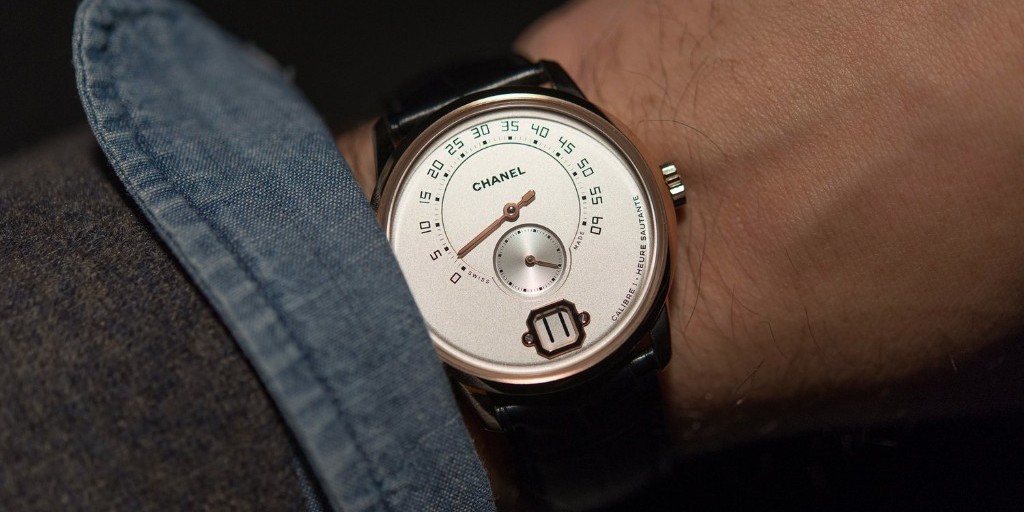Conventional wisdom has it that fashion houses are unwilling (or unable–take your pick) to unveil new products without the usual pomp and circumstance: the marketing glitz, the overbearing logo or marque placed obnoxiously front and center, the “luxury” markup, as it were, for an item that, devoid of House credentials, would hardly be compelling on its own. But in Paris, Chanel has clearly missed the memo.
In March at the 2016 Baselworld watch expo, it announced a handsome new timepiece, the Monsieur de Chanel. With its clean modern visage, and its quiet, subtle nods to Chanel heritage, it set watch geeks’ hearts aflutter, and like florid teenage girls at a Justin Bieber concert, they swooned in panting passion. It won compliments from Ben Clymer, founder of esteemed watch industry publication, Hodinkee, who called it “damn impressive”, and noted that the watch, with a top retail price of $36,000, “looks and feels well above its weight class.” Likewise, Ariel Adams, founder of popular watch review site, A Blog to Watch (ABTW), praised it as a dashing combination of Chanel’s “refined Parisian sense of style with a modern technical prowess horological aficionados demand.” “The debate,” he wrote decisively, “over whether fashion houses can ‘legitimately’ come out with a high-end timepiece is over.”

Apart from being the only “fashion house” timepiece of recent note to have generated this level of admiration from the watch literati, the Monsieur marks a series of firsts for an old world firm stepping into the modern luxury pool. Having cornered the ultra high-end women’s watch market over the last 25 years, it’s Chanel’s first committed foray into the men’s segment. It also marks the firm’s first complication: beyond merely telling you the time, it does so with panache, represented by a jumping hour display, and a minute hand that can be set to count down as well as up. Further still, and arguably of greatest importance, this is Chanel’s first timepiece designed and built entirely by the company itself. This includes, crucially, a new crown jewel: the Calibre 1, Chanel’s first in-house movement which took five years to develop.
Altogether, the Monsieur is a confident statement from the brand. Chanel has leapt into the men’s watch space with its gilded guns blazing. Its treatment of the watch, from development to release, has been superb–an impressive response to today’s savvier market demands, and the result of a bold, three-pronged strategy.
First, it dispensed with the dowdy feel old fashion houses tend to favor, and leaned instead on a suave, contemporary design that echoed today’s minimalist preferences in a tasteful manner (but not a design so narrowly current as to age poorly.) It’s evident that Nicolas Beau, Chanel’s international watch director, demanded that the Monsieur be reliant on its own merits, rather than its brand association. The company even went as far as designing a new, digital-influenced font for the occasion, which does the heavy lifting in giving the watch’s sparse face some personality.
Second, Chanel invested methodically in proper expertise to enable the firm to stand behind this watch as a true technical titan. It brought on a “team of eight watchmaking specialists in movement construction, testing and assembly,” which served as the brain trust during the 5 year development stretch, reported the New York Times. Then, in 2011, it acquired a stake in Romain Gauthier, a prize-winning independent Swiss watch firm, whose knowledge proved instrumental during development, and who supplied the custom parts required for the Calibre 1. Both investments were made precisely so that the ultimate end goal–matching the Monsieur’s guts with beauty–could be achieved. This, ABTW’s Mr. Adams suggests, is “the start of a new strategy for Chanel’s watch department, [which] feels their future for men’s watches is more about serious mechanics and complexity versus trendy looks and pop design.”
Finally, Chanel set a high price and capped production runs (300 pieces total: 150 in 18k beige gold, and 18k white gold, at $36,000 and $34,500, respectively). While not a product-driven tactic in relation to the prior two mentioned, it guarantees that the Monsieur stays special. With its limited availability and good looks, the fortunate few who end up owning one will certainly appreciate it more knowing they’re unlikely to see it on any other wrists in their circles.
Chanel, in a sense, has flubbed its lines. Today’s old fashion houses, goes the script, are not expected to be this comprehensive and thoughtful in the products they usher to market. But we can’t help but salute a company that puts the consumer before the brand, takes bold risk, and demonstrates unflappable conviction. Chanel’s decision to launch the Monsieur is exactly that.






